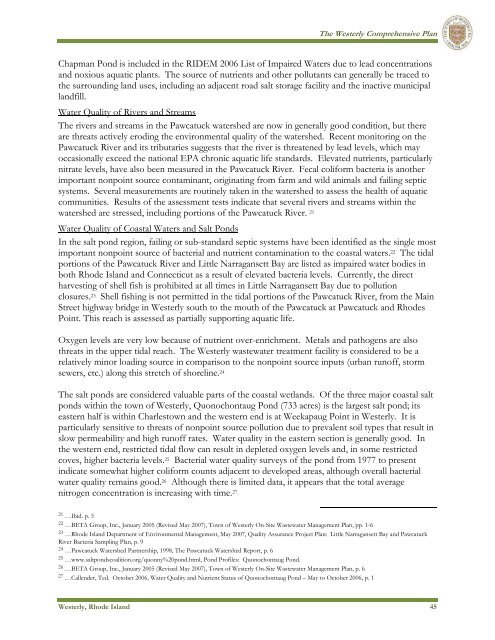Westerly - State of Rhode Island: Division of Planning
Westerly - State of Rhode Island: Division of Planning
Westerly - State of Rhode Island: Division of Planning
You also want an ePaper? Increase the reach of your titles
YUMPU automatically turns print PDFs into web optimized ePapers that Google loves.
The <strong>Westerly</strong> Comprehensive PlanChapman Pond is included in the RIDEM 2006 List <strong>of</strong> Impaired Waters due to lead concentrationsand noxious aquatic plants. The source <strong>of</strong> nutrients and other pollutants can generally be traced tothe surrounding land uses, including an adjacent road salt storage facility and the inactive municipallandfill.Water Quality <strong>of</strong> Rivers and StreamsThe rivers and streams in the Pawcatuck watershed are now in generally good condition, but thereare threats actively eroding the environmental quality <strong>of</strong> the watershed. Recent monitoring on thePawcatuck River and its tributaries suggests that the river is threatened by lead levels, which mayoccasionally exceed the national EPA chronic aquatic life standards. Elevated nutrients, particularlynitrate levels, have also been measured in the Pawcatuck River. Fecal coliform bacteria is anotherimportant nonpoint source contaminant, originating from farm and wild animals and failing septicsystems. Several measurements are routinely taken in the watershed to assess the health <strong>of</strong> aquaticcommunities. Results <strong>of</strong> the assessment tests indicate that several rivers and streams within thewatershed are stressed, including portions <strong>of</strong> the Pawcatuck River. 21Water Quality <strong>of</strong> Coastal Waters and Salt PondsIn the salt pond region, failing or sub-standard septic systems have been identified as the single mostimportant nonpoint source <strong>of</strong> bacterial and nutrient contamination to the coastal waters. 22 The tidalportions <strong>of</strong> the Pawcatuck River and Little Narragansett Bay are listed as impaired water bodies inboth <strong>Rhode</strong> <strong>Island</strong> and Connecticut as a result <strong>of</strong> elevated bacteria levels. Currently, the directharvesting <strong>of</strong> shell fish is prohibited at all times in Little Narragansett Bay due to pollutionclosures. 23 Shell fishing is not permitted in the tidal portions <strong>of</strong> the Pawcatuck River, from the MainStreet highway bridge in <strong>Westerly</strong> south to the mouth <strong>of</strong> the Pawcatuck at Pawcatuck and <strong>Rhode</strong>sPoint. This reach is assessed as partially supporting aquatic life.Oxygen levels are very low because <strong>of</strong> nutrient over-enrichment. Metals and pathogens are alsothreats in the upper tidal reach. The <strong>Westerly</strong> wastewater treatment facility is considered to be arelatively minor loading source in comparison to the nonpoint source inputs (urban run<strong>of</strong>f, stormsewers, etc.) along this stretch <strong>of</strong> shoreline. 24The salt ponds are considered valuable parts <strong>of</strong> the coastal wetlands. Of the three major coastal saltponds within the town <strong>of</strong> <strong>Westerly</strong>, Quonochontaug Pond (733 acres) is the largest salt pond; itseastern half is within Charlestown and the western end is at Weekapaug Point in <strong>Westerly</strong>. It isparticularly sensitive to threats <strong>of</strong> nonpoint source pollution due to prevalent soil types that result inslow permeability and high run<strong>of</strong>f rates. Water quality in the eastern section is generally good. Inthe western end, restricted tidal flow can result in depleted oxygen levels and, in some restrictedcoves, higher bacteria levels. 25 Bacterial water quality surveys <strong>of</strong> the pond from 1977 to presentindicate somewhat higher coliform counts adjacent to developed areas, although overall bacterialwater quality remains good. 26 Although there is limited data, it appears that the total averagenitrogen concentration is increasing with time. 2721 …Ibid. p. 522 …BETA Group, Inc., January 2005 (Revised May 2007), Town <strong>of</strong> <strong>Westerly</strong> On-Site Wastewater Management Plan, pp. 1-623 …<strong>Rhode</strong> <strong>Island</strong> Department <strong>of</strong> Environmental Management, May 2007, Quality Assurance Project Plan: Little Narragansett Bay and PawcatuckRiver Bacteria Sampling Plan, p. 924 …Pawcatuck Watershed Partnership, 1998, The Pawcatuck Watershed Report, p. 625 …www.saltpondscoalition.org/quonny%20pond.html, Pond Pr<strong>of</strong>iles: Quonochontaug Pond.26 …BETA Group, Inc., January 2005 (Revised May 2007), Town <strong>of</strong> <strong>Westerly</strong> On-Site Wastewater Management Plan, p. 627 …Callender, Ted. October 2006, Water Quality and Nutrient Status <strong>of</strong> Quonochontaug Pond – May to October 2006, p. 1<strong>Westerly</strong>, <strong>Rhode</strong> <strong>Island</strong> 45
















